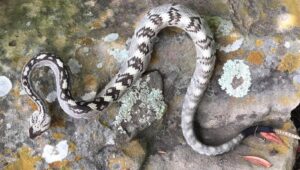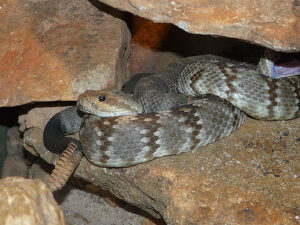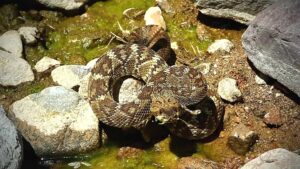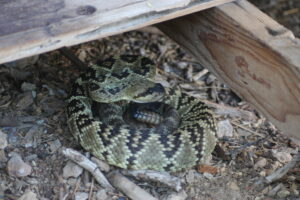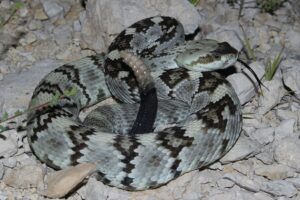The black-tailed rattlesnake, blacktail rattlesnake, or green rattler is a medium-sized pit viper species living in the southwestern United States and Mexico. It is mainly diurnal in the spring and fall. But it turns nocturnal in summer to avoid the heat. Winter sees them hibernate, often with other snake species, in the dens created and abandoned by other animals.
Depending on the substrate they need to cross, their movement varies between rectilinear motion and sidewinding. Though an excellent swimmer and able climber, this snake is predominantly terrestrial.
Scientific Classifications
- Suborder:Serpentes
- Family:Viperidae
- Genus:Crotalus
- Species:C. molossus
Conservation Status
Subspecies
This snake has three recognized subspecies.
- Northern black-tailed rattlesnake (Crotalus molossus molossus)
- Mexican black-tailed rattlesnake (Crotalus molossus nigrescens)
- Oaxacan black-tailed rattlesnake (Crotalus molossus oaxacus)
Description
Size
The average size of the snake is 30-42 in (76-107 cm). The large individuals are usually not more than 39 in (100 cm). The females tend to be bigger than the males.
Color and Appearance
Their color ranges from olive greens and yellows to browns and black. An identifying feature of the species is that they have completely black tail scales, irrespective of the variations in their body color. Often it has a black band going across the eyes and extending diagonally down to the corners of the mouth. This pattern looks like a face ‘mask’.
As with other rattlesnakes, it has a rattle made up of keratin at the end of its tail. Each time it sheds, the rattle gets a new segment.
Are They Dangerous to Humans
A curious nature and calm demeanor make the pit viper one of the most docile rattlesnakes. It rarely bites and depends mainly on camouflage to avoid detection. It tries to escape when confronted but sounds its rattle when cornered. Biting is its last resort.
The black-tailed rattlesnake has larger venom glands than most rattlesnakes in the region. Like most crotalids, the venom of the black-tailed rattlesnake is primarily hemotoxic. But being only two-thirds as toxic as that of the western diamondback, it is not fatal to humans. Bites are often treated with CroFab antivenom. Low toxicity is also why it needs to inject large quantities of venom into its prey to become effective.
Black-tailed Rattlesnakes at a Glance
Distribution
The black-tailed rattlesnake inhabits New Mexico, Arizona, central and west Texas in the US, and Mexico as far down south as Oaxaca. It is also found in the Gulf of California on Tiburón and San Estéban Islands.
Habitat
The serpent lives in desert areas, grasslands, mountainous and rocky regions, and high-altitude forests.
Lifespan
The black-tailed rattlesnake lives for 15-20 years on average.
Predators
It is preyed upon by hawks, eagles, coyotes, bobcats, and other snakes like the western diamondback rattlesnake.
Diet
Its primary food sources are birds, rodents, other small mammals, and small reptiles (like small lizards).
Reproduction
Ovoviviparous (gives birth to live young from eggs that hatch inside the body)
Breeding takes place in spring when the males track the females using the pheromone trails. Copulation can last for hours and occur many times over days. Post-mating, the male stays close to the female for several days to prevent other males from mating with her.
The babies are born in summer and stay with their mother until they wander away on their own in less than 1-2 days. A litter can have as many as 10-12 young, but the average size is 4-6.

